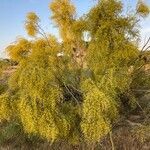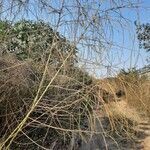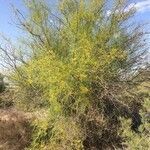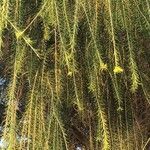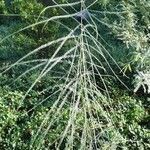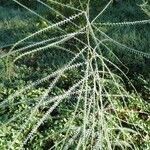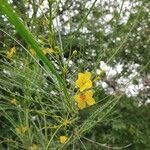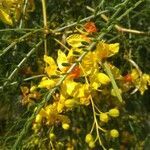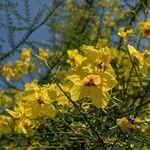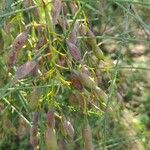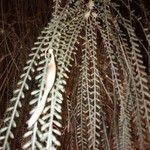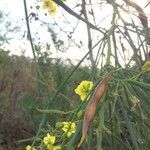Xerophytic shrubs or small trees to several m. tall, the branchlets subglabrous, more or less flexuous and gnarled. Leaves multifoliolate, twice compound as de-scribed for the genus; petiole and rachis modified into a spine 5-15 mm. long, bearing from the upper side 1-3 pairs of pinnae; pinnae multifoliolate, the rachis linear, 2-3 din. long and 1-2 mm. wide, flattened, green; ultimate leaflets about 25 pairs, linear-oblong, 2-8 mm. long and up to 2 mm. wide, often caducous. Racemes up to 2 dm. long, subglabrous; bracts lanceolate, about 1 mm. long; pedicels slender, 1-2 cm. long in age. Flowers yellow; calyx-tube turbinate, scarcely 2 mm. long; calyx-lobes ovate-lanceolate, 6-7 mm. long and about 3 mm. wide, subglabrous; petals 5, about 13 mm. long, the blade suborbicular. about 8 mm. long, claw pubescent at base, about 5 mm. long; stamens 8-9 mm. long, pubescent basally; ovary linear-oblong, about 4 mm. long, hispid; style linear, about equalling the stamens, glabrous; stigma terminal, minute. Legume linear, up to about 15 cm. long, nodose by constriction between the seeds, glabrous, striate-nerved; seeds about 1 cm. long.
Shrub or small tree, 3-4 m tall; young shoots zigzag, glabrous, stiff thorns up 3 cm long. Stipules 2, forming short spines. Leaf petiole and rachis rather short, up to c. 2 cm long; pinnae with rachis up to 25(-40) cm long. Leaflets numerous, very small, obovate, oblong, 2-5(-8.5) by l-1.5(-3.5) mm. Inflorescences up to 20 cm long; pedicels up to 10( — 15) mm, articulated below the glabrous flower. Calyx lobes ovate-oblong, 5-7 mm long, glabrous, reflexed. Petals very thin, golden yellow, spoon-shaped with the limb suborbicular or broadly ovate (c. 7 mm wide) and the claw hairy, 12-14 mm long. Stamens shorter than the petals; filaments hairy in the lower half, widened towards the base; anthers ellipsoid, dehiscing longitudinally. Ovary subsessile, hairy; style glabrous; stigma obscure. Pods cylindric, 5-15 by c. 0.7 cm, glabrous, yellowish. Seeds oblong, c. 10 by 4 mm, slightly compressed.
Shrub or tree to 8 m high with stout spines (modified leaf rachises). Leaves sometimes with spinescent stipules, and with 1–3 pairs of slender, green pinnae inserted close together near the base of the spinescent rachis, resembling 2–6 simply pinnate leaves borne on a short spine; spines (rachises) 2–17 mm long; pinnae (secondary rachises) to 40 cm long, winged, to 2.5 mm wide with up to 80 opposite or alternate, obovate-elliptic, obovate-oblong or oblong leaflets to 9 mm long and 3 mm wide along each margin, or sometimes leaflets absent or deciduous. Racemes lax, to 20 cm long. Flowers pedicellate; receptacle consisting of a disc c. 3 mm diam. and a lower elongate part simulating the pedicel. Sepals 5–7 mm long. Petals yellow. Pod usually ±straight, mostly 3–12 cm long, 5–8 mm wide, attenuate at both ends, ±flattened, often somewhat constricted. Seeds elliptic-oblong.
Evergreen, small tree or shrub, 6-9 m high; not climbing, armed with stout spines, eglandular. Leaves at first pinnate, later bipinnate, with common petiole sometimes flattened, often ending in a spine. Leaflets ± opposite, small or obsolete. Stipules often short, spinescent. Inflorescences axillary racemes. Flowers bisexual, irregular, yellow, fragrant. Calyx: tube campanulate; lobes 5, ± imbricate. Petals 5, spreading, clawed. Stamens 10, free. Ovary free, shortly stalked, many-ovuled. Flowering time Oct.-Apr. Pod linear to ± elliptic, nearly straight, subbivalved, sometimes constricted between seeds. Seeds oblong, hard, compressed.
A shrub or small tree. It grows 3-4 m tall but can be 10 m tall. It can have one or several stems. The bark is smooth and green. The smooth branches are zigzagged. It is spiny and has drooping branches. The spines are at the base of each leaf. The leaves are long and thin. They are compound with unusual leaflets. They are small and widely spaced along the flattened leaf stalk. There is a spine at the end. The flowers are yellow and have one red-brown petal. They have a scent. The fruit are straight pods 10 cm long. These are constricted between the seeds. The pods turn brown when ripe. The seeds are oblong and dark brown.
Leaves with 1–2(3) pairs of very long narrow pinnae inserted very close together near the base of the spinescent rachis, so looking like 2 or 4(6) simple pinnate leaves borne on a short spine; spines (rachis) 0.2–1.7 cm long; pinnae up to 40 cm long, their rachis broadly winged and so appearing flattened, up to 2.5 mm broad; leaflets up to 6(9) × 2(3) mm, oblong or oblanceolate, opposite or alternate, up to 80 along each margin of the rachis, or sometimes absent or caducous; stipules often spinescent like the rachis.
Shrubs or trees, to 6 m tall, prickly, with smooth, green bark. Leaf rachis and stipules becoming spines; pinnae 1-3 pairs, clustered at spinescent, very short rachis of leaves; rachis of pinnae green, to 40 cm; leaflets obovate-elliptic to obovate-oblong or oblong, 2.5-8.5 × 1-3.5 mm. Racemes sparsely flowered. Flowers yellow; pedicels 1.5-1.7 cm; bracts lanceolate. Sepals oblong, ca. 6 mm, apex obtuse. Petals spatulate, apex rounded, uppermost longer, ca. 11 × 6 mm. Filaments villous at base. Legume 7.5-10.5 cm.
Shrub or tree, up to 8 m high. Leaf rhachis spinescent; pinnae rhachillae up to 400 mm long, laterally winged and thus appearing flattened, usually with numerous opposite or alternate leaflets along each margin. Stipules usually spinescent. Flowers yellow and orange-red.
Pods (2)3–12(15) × 0.5–0.8 cm, linear, compressed, usually ± straight, constricted between the seeds, glabrous, light grey-brown; seeds up to 8 but commonly only 1–4 developing, c.9 × 6 × 2.5 mm, elliptic-oblong, light brown with dark markings.
Stems subglabrous or shortly appressed-pubescent when young, armed with short spines derived from modification of the leaf rachis or sometimes stipules as well.
Flowers in fairly lax racemes up to 20 cm long; bracts up to 2 mm long, caducous; pedicels 7–16 mm long excluding the elongate lower part of the hypanthium.
Receptacle forming a narrow disc about 1 mm broad and an elongate lower part up to 3(4) mm long, shorter than the pedicel proper.
Sepals 5–7 mm long, oblong, narrowly imbricate, becoming reflexed in full flower, with few short hairs or subglabrous.
Planted in native towns throughout the Sudan and elsewhere in dry localities
Petals 8–13 mm long, the standard with a distinct claw, all yellow.
Ovary clothed with longish white hairs, glabrescent.
An exotic shrub or small tree, 10–15 ft. high
Stamens 4–9 mm long; anthers 1.3–2 mm long.
Shrub or small tree up to 8(13) m high.
Fairly conspicuous yellow flowers
